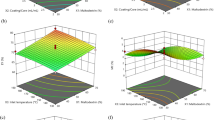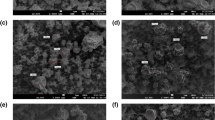Abstract
Banana peel, a by-product rich in phenolics and other bioactive compounds, has great potentials as a natural preservative or healthy food ingredient. However, the instability of bioactive compounds derived from banana peel limits their applications, and as such encapsulation is necessary to improve their stability and widen their applications. This study investigated the impact of spray drying conditions and coating materials on the physical, phytochemical, and antioxidant properties of the peel extract to identify the most suitable encapsulation process. The results showed that inlet temperature (ranging from 140 to 180 °C) and feeding rate (3–15 mL/min) did not significantly affect the total phenolic content (TPC) and antioxidant capacity but influenced the moisture content and recovery yield of the powder. The ratio of dry matter in fresh extract-to-coating material (DM-to-CM) (1:1–1:7 (w/w)) did not affect the moisture content. However, it affected the TPC, antioxidant properties, and recovery yield of the powder. Finally, the type of coating materials did not significantly affect TPC and antioxidant properties, but other physical properties, dopamine levels and recovery yield. The most suitable encapsulation conditions were identified as an inlet drying temperature of 150 °C, a feeding rate of 9 mL/min, a ratio of DM-to-CM of 1:1 (w/w), and coating with a combination of maltodextrin M100 and gum acacia. Powder prepared under the most suitable conditions had a spherical shape with a rough surface and had stable TPC under storage conditions of 40 °C for 4 weeks. It also has ideal physical, phytochemical and antioxidant properties and is suitable for further applications.

Similar content being viewed by others
References
Akhavan Mahdavi S, Jafari SM, Assadpoor E, Dehnad D (2016) Microencapsulation optimization of natural anthocyanins with maltodextrin, gum Arabic and gelatin. Int J Biol Macromol 85:379–385
Ballesteros LF, Ramirez MJ, Orrego CE, Teixeira JA, Mussatto SI (2017) Encapsulation of antioxidant phenolic compounds extracted from spent coffee grounds by freeze-drying and spray-drying using different coating materials. Food Chem 237:623–631
Baskar R, Shrisakthi S, Sathyapriya B, Shyampriya R, Nithya R, Poongodi P (2011) Antioxidant potential of peel extracts of banana varieties (Musa sapientum). Food Nutr Sci 02(10):1128–1133
Çam M, İçyer NC, Erdoğan F (2014) Pomegranate peel phenolics: microencapsulation, storage stability and potential ingredient for functional food development. LWT Food Sci Technol 55(1):117–123
Davey MW, Keulemans J, Swennen R (2006) Methods for the efficient quantification of fruit provitamin A contents. J Chromatogr A 1136(2):176–184
Fang Z, Bhandari B (2010) Encapsulation of polyphenols—a review. Trends Food Sci Technol 21(10):510–523
Fatemeh SR, Saifullah R, Abbas FMA, Azhar ME (2012) Total phenolics, flavonoids and antioxidant activity of banana pulp and peel flours: influence of variety and stage of ripeness. Int Food Res J 19(3):1041–1046
Gharsallaoui A, Roudaut G, Chambin O, Voilley A, Saurel R (2007) Applications of spray-drying in microencapsulation of food ingredients: an overview. Food Res Int 40(9):1107–1121
Imam MZ, Akter S (2011) Musa paradisiaca L. and Musa sapientum L.: a phytochemical and pharmacological review. J Appl Pharm Sci 1(05):14–20
Kha TC, Nguyen MH, Roach PD (2010) Effects of spray drying conditions on the physicochemical and antioxidant properties of the Gac (Momordica cochinchinensis) fruit aril powder. J Food Eng 98(3):385–392
Kha TC, Nguyen MH, Roach PD, Stathopoulos CE (2014a) Microencapsulation of gac oil by spray drying: optimization of wall material concentration and oil load using response surface methodology. Drying Technol 32(4):385–397
Kha TC, Nguyen MH, Roach PD, Stathopoulos CE (2014b) Microencapsulation of Gac oil: optimisation of spray drying conditions using response surface methodology. Powder Technol 264:298–309
Krokida MK, Maroulis ZB (1999) Effect of microwave drying on some quality properties of dehydrated products. Drying Technol 17(3):449–466
Kumar KPS, Bhowmik D, Duraivel S, Umadevi M (2012) Traditional and mecicinal uses of banana. Pharmacogn Phytochem 1(3):53–63
Muzaffar K, Kumar P (2015) Parameter optimization for spray drying of tamarind pulp using response surface methodology. Powder Technol 279:179–184
Nguyen TBT, Ketsa S, van Doorn WG (2003) Relationship between browning and the activities of polyphenoloxidase and phenylalanine ammonia lyase in banana peel during low temperature storage. Postharvest Biol Technol 30(2):187–193
Papoutsis K, Golding JB, Vuong Q, Pristijono P, Stathopoulos CE, Scarlett CJ, Bowyer M (2018) Encapsulation of citrus by-product extracts by spray-drying and freeze-drying using combinations of maltodextrin with soybean protein and iota-carrageenan. Foods 7(7):115
Patel BB, Patel JK, Chakraborty S, Shukla D (2015) Revealing facts behind spray dried solid dispersion technology used for solubility enhancement. Saudi Pharm J 23(4):352–365
Pereira A, Maraschin M (2015) Banana (Musa spp) from peel to pulp: ethnopharmacology, source of bioactive compounds and its relevance for human health. J Ethnopharmacol 160:149–163
Robert P, Fredes C (2015) The encapsulation of anthocyanins from berry-type fruits. Trends in foods. Molecules 20(4):5875–5888
Robert P, Gorena T, Romero N, Sepulveda E, Chavez J, Saenz C (2010) Encapsulation of polyphenols and anthocyanins from pomegranate (Punica granatum) by spray drying. Int J Food Sci Technol 45(7):1386–1394
Saikia S, Mahnot NK, Mahanta CL (2015) Optimisation of phenolic extraction from Averrhoa carambola pomace by response surface methodology and its microencapsulation by spray and freeze drying. Food Chem 171:144–152
Someya S, Yoshiki Y, Okubo K (2002) Antioxidant compounds from bananas (Musa Cavendish). Food Chem 79(3):351–354
Sulaiman SF, Yusoff NAM, Eldeen IM, Seow EM, Sajak AAB, Supriatno Ooi KL (2011) Correlation between total phenolic and mineral contents with antioxidant activity of eight Malaysian bananas (Musa sp). J Food Compos Anal 24(1):1–10
Tontul I, Topuz A (2017) Spray-drying of fruit and vegetable juices: effect of drying conditions on the product yield and physical properties. Trends Food Sci Technol 63:91–102
Tumbas Šaponjac V, Ćetković G, Čanadanović-Brunet J, Pajin B, Djilas S, Petrović J, Lončarević I, Stajčić S, Vulić J (2016) Sour cherry pomace extract encapsulated in whey and soy proteins: incorporation in cookies. Food Chem 207:27–33
Vu HT, Scarlett CJ, Vuong QV (2018) Phenolic compounds within banana peel and their potential uses: a review. J Funct Foods 40:238–248
Vu HT, Scarlett CJ, Vuong QV (2019) Maximising recovery of phenolic compounds and antioxidant properties from banana peel using microwave assisted extraction and water. J Food Sci Technol 56:1360–1370
Zhang L, Mou D, Du Y (2007) Procyanidins: extraction and micro- encapsulation. J Sci Food Agric 87(12):2192–2197
Acknowledgements
The first author would like to thank Dr Dipangkar Kundu (Australian Public Service) for the proofreading and insightful reviews, which has significantly contributed to the quality of this publication. The first author would like to thank Ms Yun Lin and staff of the University of Newcastle Electron Microscope and X-ray Unit (EMX) for their support in the SEM analysis. The first author would like to thank Grain Processing Corporation for providing samples of maltodextrin. The awarding of a VIED-TUIT scholarship to the first author from Vietnam International Education Development and the University of Newcastle is greatly acknowledged.
Author information
Authors and Affiliations
Corresponding authors
Additional information
Publisher's Note
Springer Nature remains neutral with regard to jurisdictional claims in published maps and institutional affiliations.
Rights and permissions
About this article
Cite this article
Vu, H.T., Scarlett, C.J. & Vuong, Q.V. Encapsulation of phenolic-rich extract from banana (Musa cavendish) peel. J Food Sci Technol 57, 2089–2098 (2020). https://doi.org/10.1007/s13197-020-04243-6
Revised:
Accepted:
Published:
Issue Date:
DOI: https://doi.org/10.1007/s13197-020-04243-6




